Education Teacher | Second Language Acquisition
VerifiedAdded on 2022/07/29
|10
|2052
|21
AI Summary
Contribute Materials
Your contribution can guide someone’s learning journey. Share your
documents today.

Running head: EDUCATION TEACHER
1
Education Teacher
Student’s Name
Institutional Affiliation
1
Education Teacher
Student’s Name
Institutional Affiliation
Secure Best Marks with AI Grader
Need help grading? Try our AI Grader for instant feedback on your assignments.
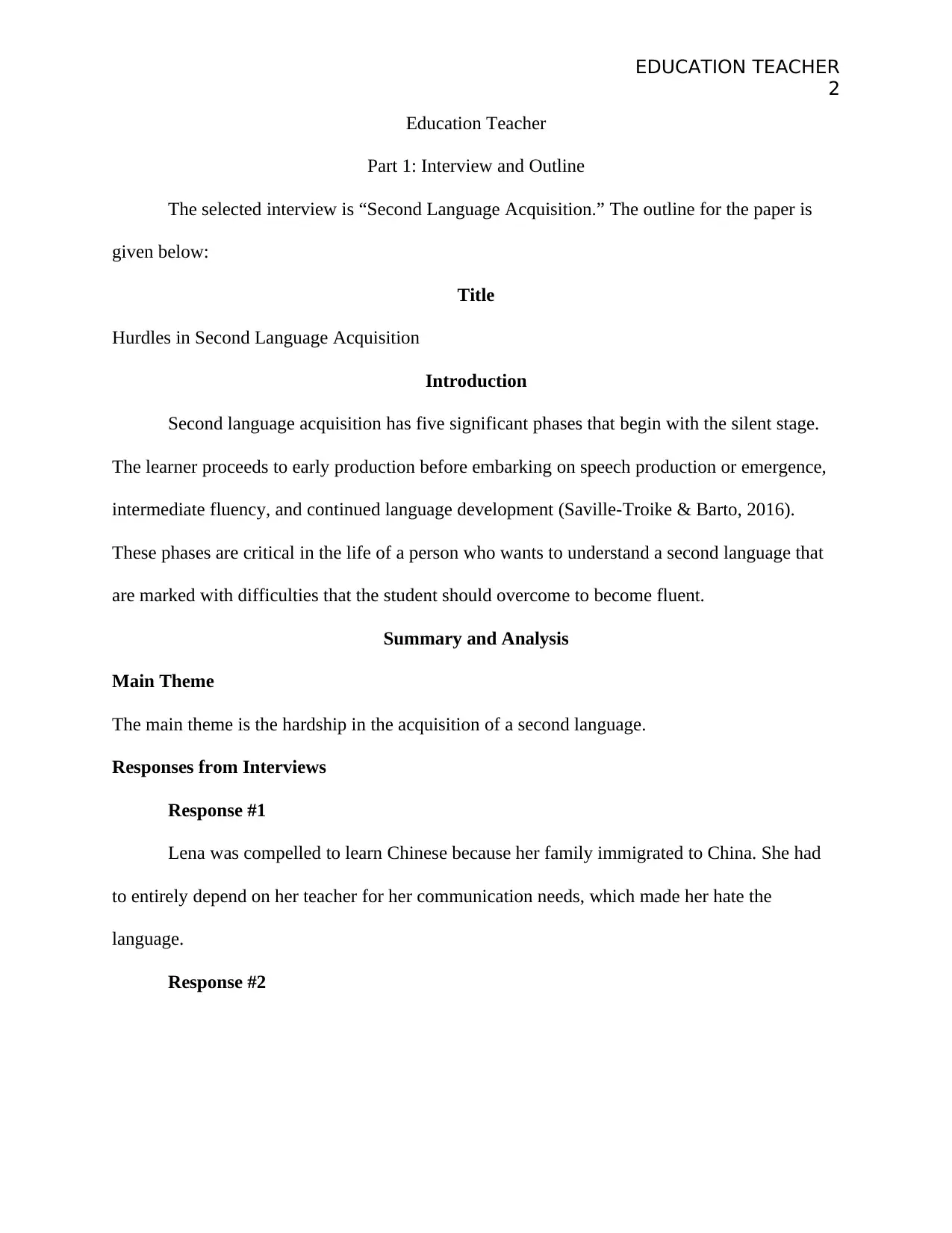
EDUCATION TEACHER
2
Education Teacher
Part 1: Interview and Outline
The selected interview is “Second Language Acquisition.” The outline for the paper is
given below:
Title
Hurdles in Second Language Acquisition
Introduction
Second language acquisition has five significant phases that begin with the silent stage.
The learner proceeds to early production before embarking on speech production or emergence,
intermediate fluency, and continued language development (Saville-Troike & Barto, 2016).
These phases are critical in the life of a person who wants to understand a second language that
are marked with difficulties that the student should overcome to become fluent.
Summary and Analysis
Main Theme
The main theme is the hardship in the acquisition of a second language.
Responses from Interviews
Response #1
Lena was compelled to learn Chinese because her family immigrated to China. She had
to entirely depend on her teacher for her communication needs, which made her hate the
language.
Response #2
2
Education Teacher
Part 1: Interview and Outline
The selected interview is “Second Language Acquisition.” The outline for the paper is
given below:
Title
Hurdles in Second Language Acquisition
Introduction
Second language acquisition has five significant phases that begin with the silent stage.
The learner proceeds to early production before embarking on speech production or emergence,
intermediate fluency, and continued language development (Saville-Troike & Barto, 2016).
These phases are critical in the life of a person who wants to understand a second language that
are marked with difficulties that the student should overcome to become fluent.
Summary and Analysis
Main Theme
The main theme is the hardship in the acquisition of a second language.
Responses from Interviews
Response #1
Lena was compelled to learn Chinese because her family immigrated to China. She had
to entirely depend on her teacher for her communication needs, which made her hate the
language.
Response #2

EDUCATION TEACHER
3
Thomas faced a similar situation where he was told the writing system avoided the
phonetics he was using in the US. The rules and patterns in Chinese are less evident than in
English, and finding a specific word in the Chinese language is a daunting task.
Literature Review
Bańka (2017) seeks to understand the challenges of teaching Chinese in universities. The
methodology deployed is a literature review. The author finds out that teaching Chinese is an
arduous task that teachers and students undertake. Students may lack exposure to these elements
of the Chinese outside the classroom context.
Wen (2015) reviews the challenges that students in Malaysia face when learning Chinese
characters. The methodology deployed is a literature review. The author contends that non-native
speakers find a daunting challenge when they attempt to learn Chinese characters. The Chinese
language has characters with various elements that may entail sounds, forms, and meanings.
Every student should learn all of these and recall them when speaking.
Yang (2018) seeks to determine the difficulty of learning Chinese characters in English
secondary schools. The methodology used is a Likert scale questionnaire and interviews. The
researcher argues that students believe character recognition is harder than writing them. They
also depict concerns between logography and the sound of specific characters.
Conclusion
A person who wants to acquire a second language needs to accept the culture of the target
people and work toward understanding the culture and, by extension, the language. Lena lacked
interest in learning Chinese because she only knew English while Thomas found it hard to
understand the tonal variations in Chinese. Learning the language needs constant practice
3
Thomas faced a similar situation where he was told the writing system avoided the
phonetics he was using in the US. The rules and patterns in Chinese are less evident than in
English, and finding a specific word in the Chinese language is a daunting task.
Literature Review
Bańka (2017) seeks to understand the challenges of teaching Chinese in universities. The
methodology deployed is a literature review. The author finds out that teaching Chinese is an
arduous task that teachers and students undertake. Students may lack exposure to these elements
of the Chinese outside the classroom context.
Wen (2015) reviews the challenges that students in Malaysia face when learning Chinese
characters. The methodology deployed is a literature review. The author contends that non-native
speakers find a daunting challenge when they attempt to learn Chinese characters. The Chinese
language has characters with various elements that may entail sounds, forms, and meanings.
Every student should learn all of these and recall them when speaking.
Yang (2018) seeks to determine the difficulty of learning Chinese characters in English
secondary schools. The methodology used is a Likert scale questionnaire and interviews. The
researcher argues that students believe character recognition is harder than writing them. They
also depict concerns between logography and the sound of specific characters.
Conclusion
A person who wants to acquire a second language needs to accept the culture of the target
people and work toward understanding the culture and, by extension, the language. Lena lacked
interest in learning Chinese because she only knew English while Thomas found it hard to
understand the tonal variations in Chinese. Learning the language needs constant practice

EDUCATION TEACHER
4
because it has five tones and homophones; thus, students should be ready to understand the
context to distinguish meanings.
4
because it has five tones and homophones; thus, students should be ready to understand the
context to distinguish meanings.
Secure Best Marks with AI Grader
Need help grading? Try our AI Grader for instant feedback on your assignments.
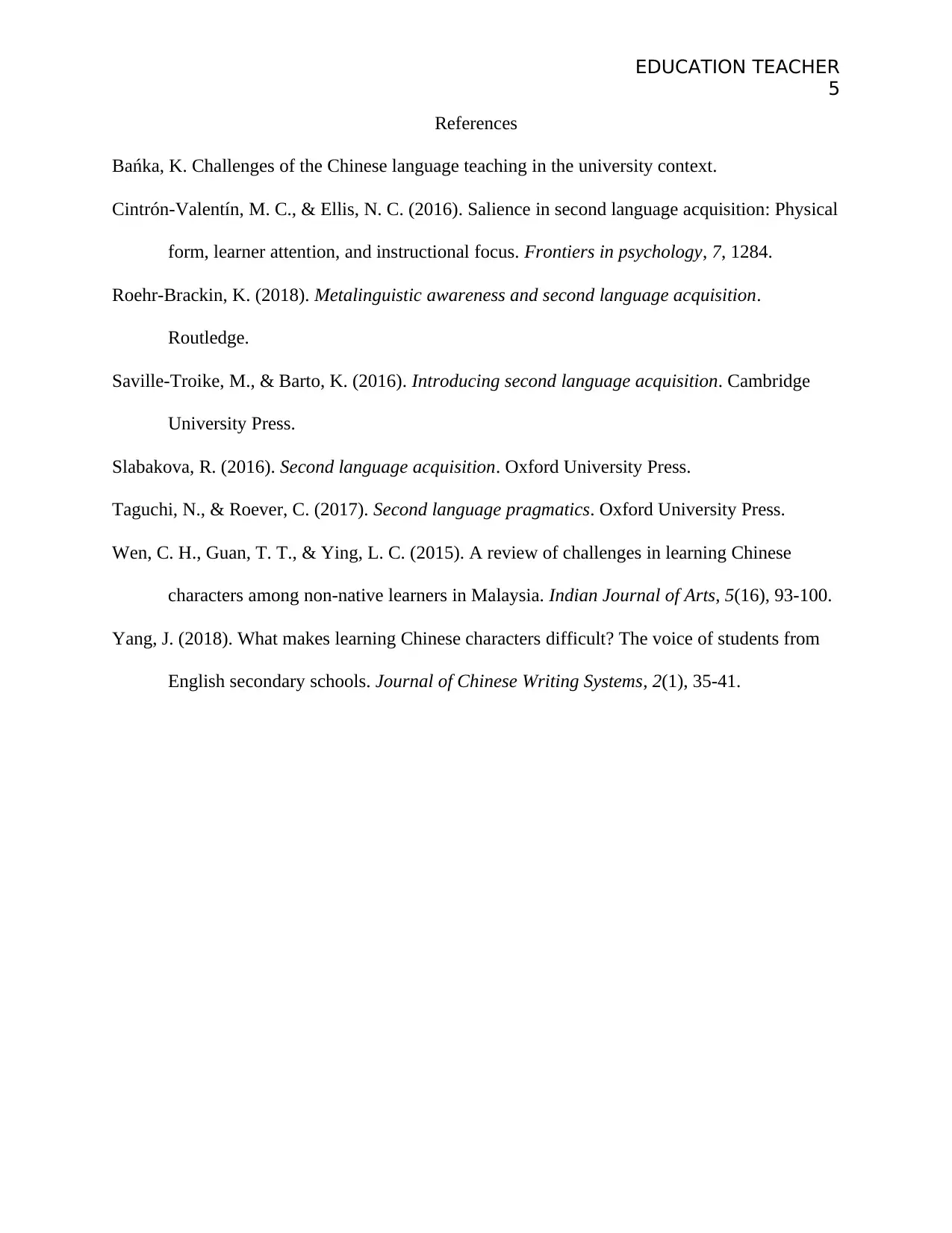
EDUCATION TEACHER
5
References
Bańka, K. Challenges of the Chinese language teaching in the university context.
Cintrón-Valentín, M. C., & Ellis, N. C. (2016). Salience in second language acquisition: Physical
form, learner attention, and instructional focus. Frontiers in psychology, 7, 1284.
Roehr-Brackin, K. (2018). Metalinguistic awareness and second language acquisition.
Routledge.
Saville-Troike, M., & Barto, K. (2016). Introducing second language acquisition. Cambridge
University Press.
Slabakova, R. (2016). Second language acquisition. Oxford University Press.
Taguchi, N., & Roever, C. (2017). Second language pragmatics. Oxford University Press.
Wen, C. H., Guan, T. T., & Ying, L. C. (2015). A review of challenges in learning Chinese
characters among non-native learners in Malaysia. Indian Journal of Arts, 5(16), 93-100.
Yang, J. (2018). What makes learning Chinese characters difficult? The voice of students from
English secondary schools. Journal of Chinese Writing Systems, 2(1), 35-41.
5
References
Bańka, K. Challenges of the Chinese language teaching in the university context.
Cintrón-Valentín, M. C., & Ellis, N. C. (2016). Salience in second language acquisition: Physical
form, learner attention, and instructional focus. Frontiers in psychology, 7, 1284.
Roehr-Brackin, K. (2018). Metalinguistic awareness and second language acquisition.
Routledge.
Saville-Troike, M., & Barto, K. (2016). Introducing second language acquisition. Cambridge
University Press.
Slabakova, R. (2016). Second language acquisition. Oxford University Press.
Taguchi, N., & Roever, C. (2017). Second language pragmatics. Oxford University Press.
Wen, C. H., Guan, T. T., & Ying, L. C. (2015). A review of challenges in learning Chinese
characters among non-native learners in Malaysia. Indian Journal of Arts, 5(16), 93-100.
Yang, J. (2018). What makes learning Chinese characters difficult? The voice of students from
English secondary schools. Journal of Chinese Writing Systems, 2(1), 35-41.
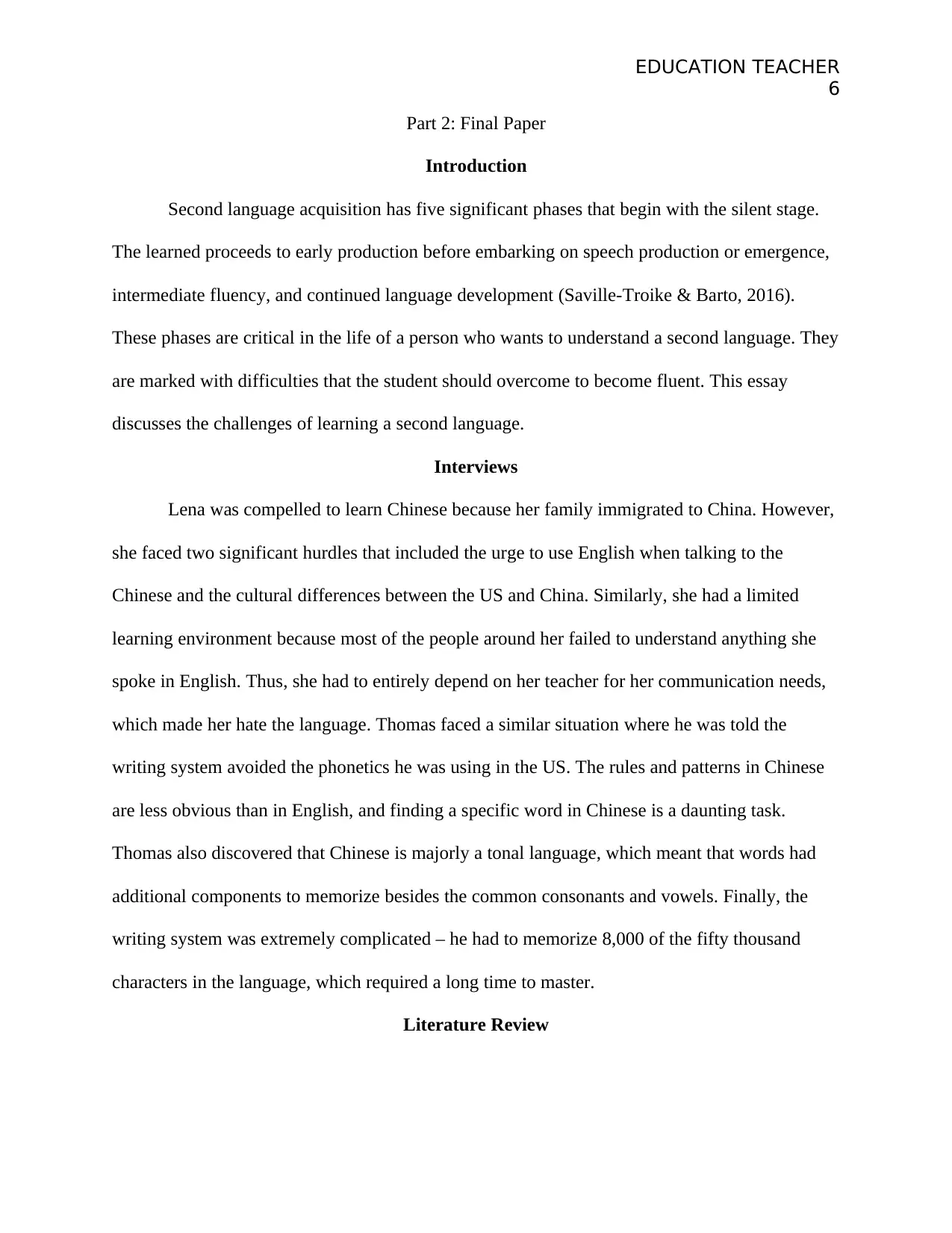
EDUCATION TEACHER
6
Part 2: Final Paper
Introduction
Second language acquisition has five significant phases that begin with the silent stage.
The learned proceeds to early production before embarking on speech production or emergence,
intermediate fluency, and continued language development (Saville-Troike & Barto, 2016).
These phases are critical in the life of a person who wants to understand a second language. They
are marked with difficulties that the student should overcome to become fluent. This essay
discusses the challenges of learning a second language.
Interviews
Lena was compelled to learn Chinese because her family immigrated to China. However,
she faced two significant hurdles that included the urge to use English when talking to the
Chinese and the cultural differences between the US and China. Similarly, she had a limited
learning environment because most of the people around her failed to understand anything she
spoke in English. Thus, she had to entirely depend on her teacher for her communication needs,
which made her hate the language. Thomas faced a similar situation where he was told the
writing system avoided the phonetics he was using in the US. The rules and patterns in Chinese
are less obvious than in English, and finding a specific word in Chinese is a daunting task.
Thomas also discovered that Chinese is majorly a tonal language, which meant that words had
additional components to memorize besides the common consonants and vowels. Finally, the
writing system was extremely complicated – he had to memorize 8,000 of the fifty thousand
characters in the language, which required a long time to master.
Literature Review
6
Part 2: Final Paper
Introduction
Second language acquisition has five significant phases that begin with the silent stage.
The learned proceeds to early production before embarking on speech production or emergence,
intermediate fluency, and continued language development (Saville-Troike & Barto, 2016).
These phases are critical in the life of a person who wants to understand a second language. They
are marked with difficulties that the student should overcome to become fluent. This essay
discusses the challenges of learning a second language.
Interviews
Lena was compelled to learn Chinese because her family immigrated to China. However,
she faced two significant hurdles that included the urge to use English when talking to the
Chinese and the cultural differences between the US and China. Similarly, she had a limited
learning environment because most of the people around her failed to understand anything she
spoke in English. Thus, she had to entirely depend on her teacher for her communication needs,
which made her hate the language. Thomas faced a similar situation where he was told the
writing system avoided the phonetics he was using in the US. The rules and patterns in Chinese
are less obvious than in English, and finding a specific word in Chinese is a daunting task.
Thomas also discovered that Chinese is majorly a tonal language, which meant that words had
additional components to memorize besides the common consonants and vowels. Finally, the
writing system was extremely complicated – he had to memorize 8,000 of the fifty thousand
characters in the language, which required a long time to master.
Literature Review
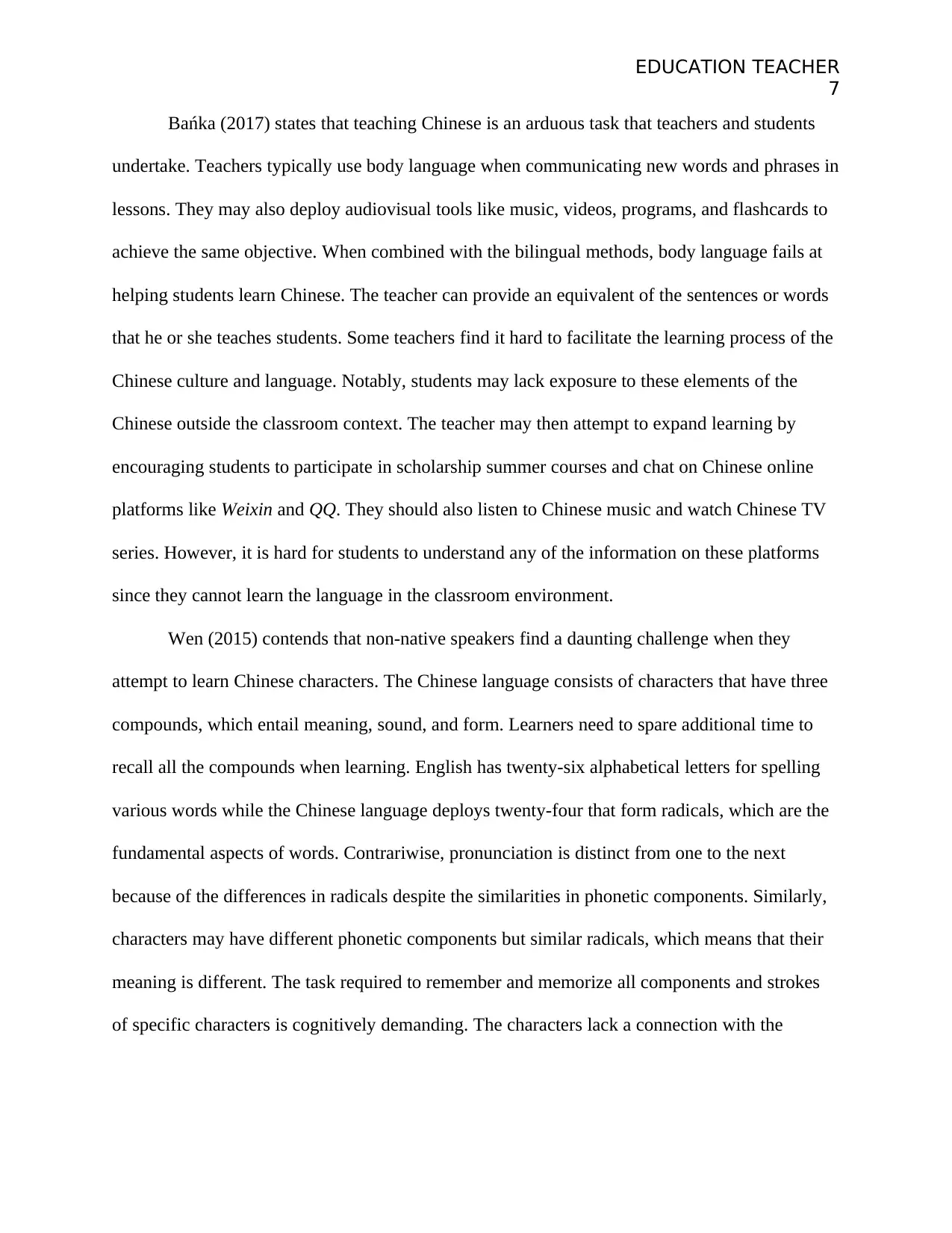
EDUCATION TEACHER
7
Bańka (2017) states that teaching Chinese is an arduous task that teachers and students
undertake. Teachers typically use body language when communicating new words and phrases in
lessons. They may also deploy audiovisual tools like music, videos, programs, and flashcards to
achieve the same objective. When combined with the bilingual methods, body language fails at
helping students learn Chinese. The teacher can provide an equivalent of the sentences or words
that he or she teaches students. Some teachers find it hard to facilitate the learning process of the
Chinese culture and language. Notably, students may lack exposure to these elements of the
Chinese outside the classroom context. The teacher may then attempt to expand learning by
encouraging students to participate in scholarship summer courses and chat on Chinese online
platforms like Weixin and QQ. They should also listen to Chinese music and watch Chinese TV
series. However, it is hard for students to understand any of the information on these platforms
since they cannot learn the language in the classroom environment.
Wen (2015) contends that non-native speakers find a daunting challenge when they
attempt to learn Chinese characters. The Chinese language consists of characters that have three
compounds, which entail meaning, sound, and form. Learners need to spare additional time to
recall all the compounds when learning. English has twenty-six alphabetical letters for spelling
various words while the Chinese language deploys twenty-four that form radicals, which are the
fundamental aspects of words. Contrariwise, pronunciation is distinct from one to the next
because of the differences in radicals despite the similarities in phonetic components. Similarly,
characters may have different phonetic components but similar radicals, which means that their
meaning is different. The task required to remember and memorize all components and strokes
of specific characters is cognitively demanding. The characters lack a connection with the
7
Bańka (2017) states that teaching Chinese is an arduous task that teachers and students
undertake. Teachers typically use body language when communicating new words and phrases in
lessons. They may also deploy audiovisual tools like music, videos, programs, and flashcards to
achieve the same objective. When combined with the bilingual methods, body language fails at
helping students learn Chinese. The teacher can provide an equivalent of the sentences or words
that he or she teaches students. Some teachers find it hard to facilitate the learning process of the
Chinese culture and language. Notably, students may lack exposure to these elements of the
Chinese outside the classroom context. The teacher may then attempt to expand learning by
encouraging students to participate in scholarship summer courses and chat on Chinese online
platforms like Weixin and QQ. They should also listen to Chinese music and watch Chinese TV
series. However, it is hard for students to understand any of the information on these platforms
since they cannot learn the language in the classroom environment.
Wen (2015) contends that non-native speakers find a daunting challenge when they
attempt to learn Chinese characters. The Chinese language consists of characters that have three
compounds, which entail meaning, sound, and form. Learners need to spare additional time to
recall all the compounds when learning. English has twenty-six alphabetical letters for spelling
various words while the Chinese language deploys twenty-four that form radicals, which are the
fundamental aspects of words. Contrariwise, pronunciation is distinct from one to the next
because of the differences in radicals despite the similarities in phonetic components. Similarly,
characters may have different phonetic components but similar radicals, which means that their
meaning is different. The task required to remember and memorize all components and strokes
of specific characters is cognitively demanding. The characters lack a connection with the
Paraphrase This Document
Need a fresh take? Get an instant paraphrase of this document with our AI Paraphraser
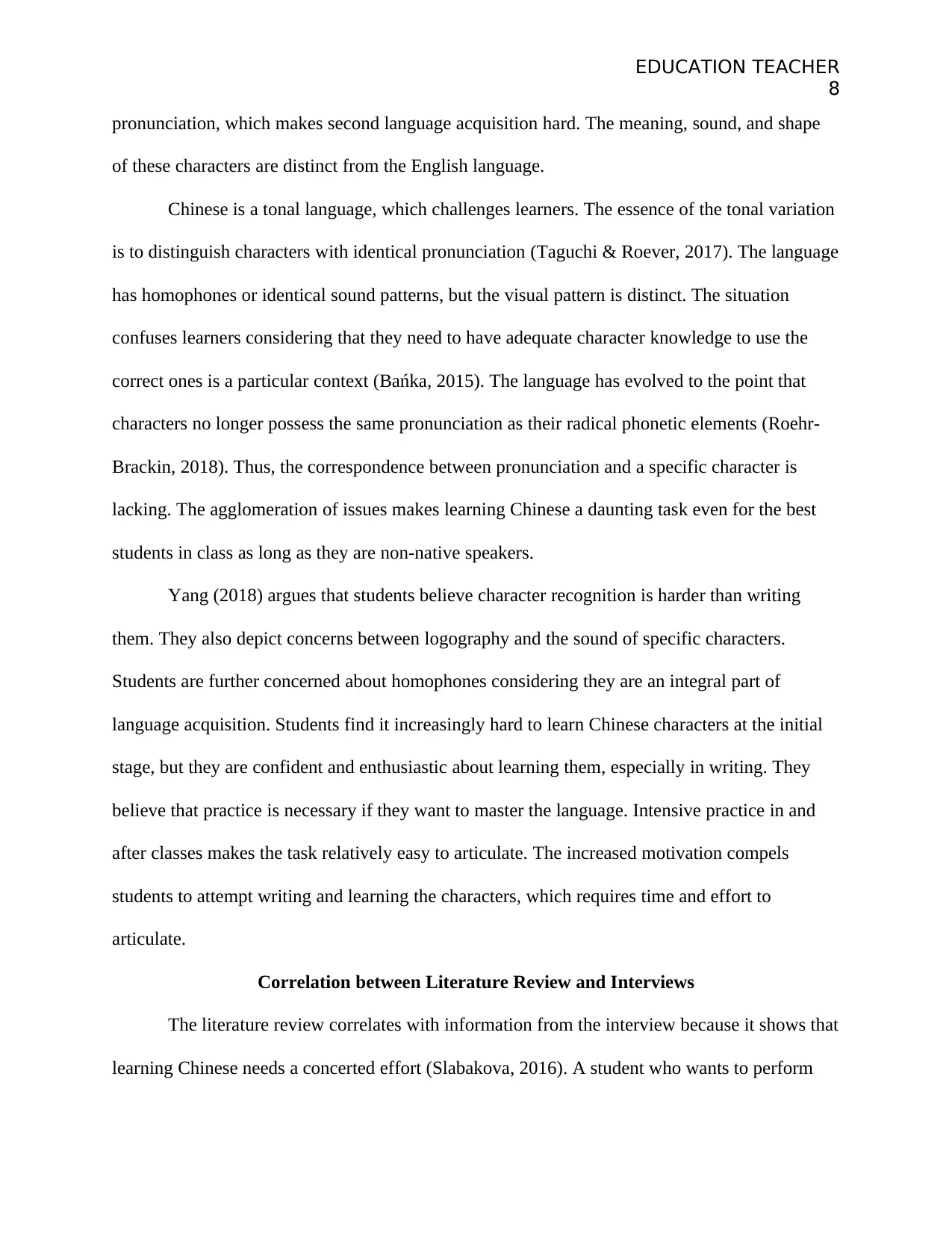
EDUCATION TEACHER
8
pronunciation, which makes second language acquisition hard. The meaning, sound, and shape
of these characters are distinct from the English language.
Chinese is a tonal language, which challenges learners. The essence of the tonal variation
is to distinguish characters with identical pronunciation (Taguchi & Roever, 2017). The language
has homophones or identical sound patterns, but the visual pattern is distinct. The situation
confuses learners considering that they need to have adequate character knowledge to use the
correct ones is a particular context (Bańka, 2015). The language has evolved to the point that
characters no longer possess the same pronunciation as their radical phonetic elements (Roehr-
Brackin, 2018). Thus, the correspondence between pronunciation and a specific character is
lacking. The agglomeration of issues makes learning Chinese a daunting task even for the best
students in class as long as they are non-native speakers.
Yang (2018) argues that students believe character recognition is harder than writing
them. They also depict concerns between logography and the sound of specific characters.
Students are further concerned about homophones considering they are an integral part of
language acquisition. Students find it increasingly hard to learn Chinese characters at the initial
stage, but they are confident and enthusiastic about learning them, especially in writing. They
believe that practice is necessary if they want to master the language. Intensive practice in and
after classes makes the task relatively easy to articulate. The increased motivation compels
students to attempt writing and learning the characters, which requires time and effort to
articulate.
Correlation between Literature Review and Interviews
The literature review correlates with information from the interview because it shows that
learning Chinese needs a concerted effort (Slabakova, 2016). A student who wants to perform
8
pronunciation, which makes second language acquisition hard. The meaning, sound, and shape
of these characters are distinct from the English language.
Chinese is a tonal language, which challenges learners. The essence of the tonal variation
is to distinguish characters with identical pronunciation (Taguchi & Roever, 2017). The language
has homophones or identical sound patterns, but the visual pattern is distinct. The situation
confuses learners considering that they need to have adequate character knowledge to use the
correct ones is a particular context (Bańka, 2015). The language has evolved to the point that
characters no longer possess the same pronunciation as their radical phonetic elements (Roehr-
Brackin, 2018). Thus, the correspondence between pronunciation and a specific character is
lacking. The agglomeration of issues makes learning Chinese a daunting task even for the best
students in class as long as they are non-native speakers.
Yang (2018) argues that students believe character recognition is harder than writing
them. They also depict concerns between logography and the sound of specific characters.
Students are further concerned about homophones considering they are an integral part of
language acquisition. Students find it increasingly hard to learn Chinese characters at the initial
stage, but they are confident and enthusiastic about learning them, especially in writing. They
believe that practice is necessary if they want to master the language. Intensive practice in and
after classes makes the task relatively easy to articulate. The increased motivation compels
students to attempt writing and learning the characters, which requires time and effort to
articulate.
Correlation between Literature Review and Interviews
The literature review correlates with information from the interview because it shows that
learning Chinese needs a concerted effort (Slabakova, 2016). A student who wants to perform

EDUCATION TEACHER
9
well at the acquisition of the Chinese language should be ready to find the inner motivation to
learn the language (Cintrón-Valentín & Ellis, 2016). Lena and Thomas lacked interest when they
discovered that the phonetics of Chinese are different from the English language. However, they
soon learned that practicing was key to the acquisition of the new language. Thus, they began to
embrace the culture of the Chinese, which assisted them in the learning process.
Conclusion
A person who wants to acquire a second language needs to accept the culture of the target
people and work toward understanding the culture and, by extension, the language. Lena lacked
interest in learning Chinese because she only knew English while Thomas found it hard to
understand the tonal variations in Chinese. Learning the language needs constant practice
because it has five tones and different characters from those in English. The language also has
homophones; thus, students should be ready to understand the context to distinguish meanings.
9
well at the acquisition of the Chinese language should be ready to find the inner motivation to
learn the language (Cintrón-Valentín & Ellis, 2016). Lena and Thomas lacked interest when they
discovered that the phonetics of Chinese are different from the English language. However, they
soon learned that practicing was key to the acquisition of the new language. Thus, they began to
embrace the culture of the Chinese, which assisted them in the learning process.
Conclusion
A person who wants to acquire a second language needs to accept the culture of the target
people and work toward understanding the culture and, by extension, the language. Lena lacked
interest in learning Chinese because she only knew English while Thomas found it hard to
understand the tonal variations in Chinese. Learning the language needs constant practice
because it has five tones and different characters from those in English. The language also has
homophones; thus, students should be ready to understand the context to distinguish meanings.
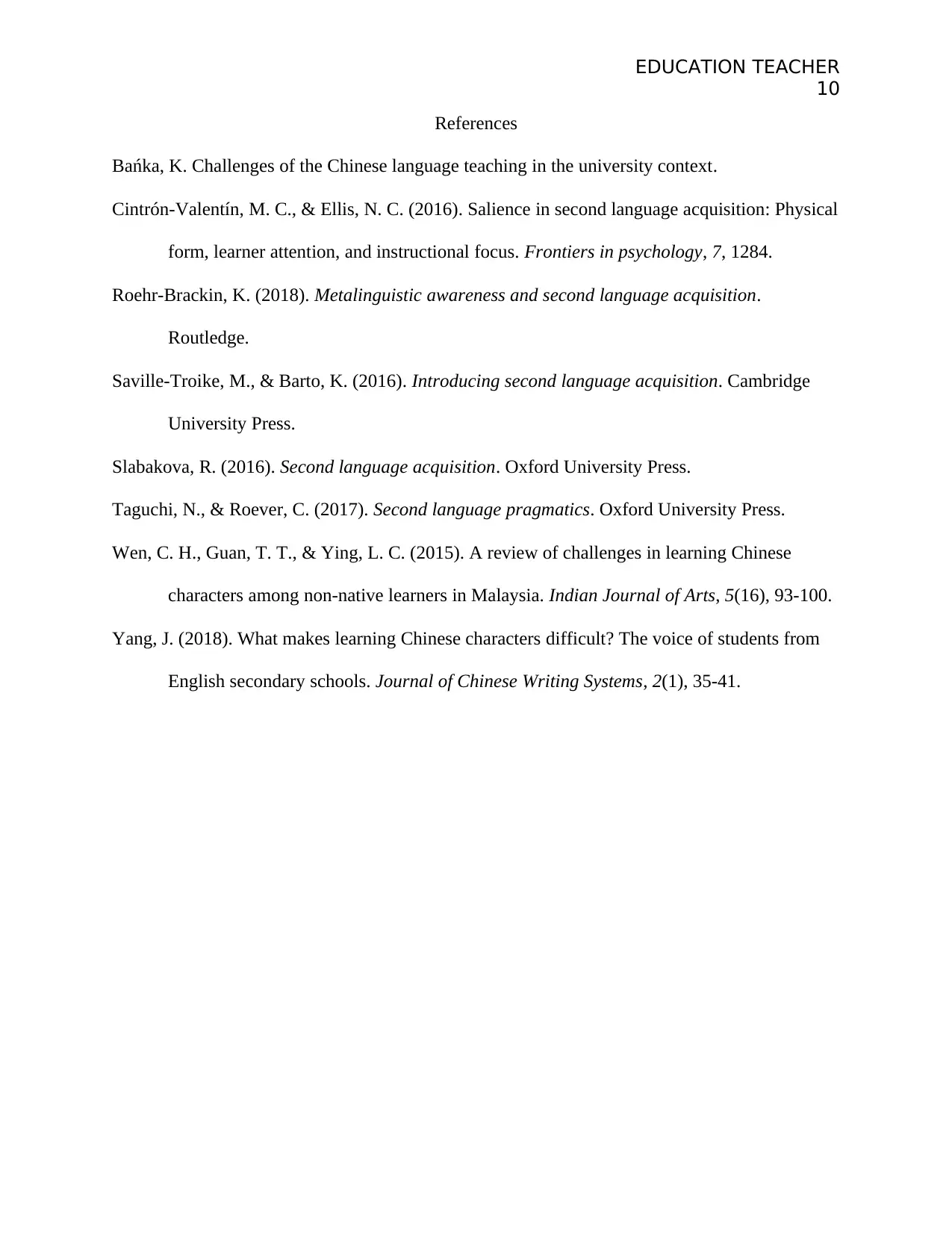
EDUCATION TEACHER
10
References
Bańka, K. Challenges of the Chinese language teaching in the university context.
Cintrón-Valentín, M. C., & Ellis, N. C. (2016). Salience in second language acquisition: Physical
form, learner attention, and instructional focus. Frontiers in psychology, 7, 1284.
Roehr-Brackin, K. (2018). Metalinguistic awareness and second language acquisition.
Routledge.
Saville-Troike, M., & Barto, K. (2016). Introducing second language acquisition. Cambridge
University Press.
Slabakova, R. (2016). Second language acquisition. Oxford University Press.
Taguchi, N., & Roever, C. (2017). Second language pragmatics. Oxford University Press.
Wen, C. H., Guan, T. T., & Ying, L. C. (2015). A review of challenges in learning Chinese
characters among non-native learners in Malaysia. Indian Journal of Arts, 5(16), 93-100.
Yang, J. (2018). What makes learning Chinese characters difficult? The voice of students from
English secondary schools. Journal of Chinese Writing Systems, 2(1), 35-41.
10
References
Bańka, K. Challenges of the Chinese language teaching in the university context.
Cintrón-Valentín, M. C., & Ellis, N. C. (2016). Salience in second language acquisition: Physical
form, learner attention, and instructional focus. Frontiers in psychology, 7, 1284.
Roehr-Brackin, K. (2018). Metalinguistic awareness and second language acquisition.
Routledge.
Saville-Troike, M., & Barto, K. (2016). Introducing second language acquisition. Cambridge
University Press.
Slabakova, R. (2016). Second language acquisition. Oxford University Press.
Taguchi, N., & Roever, C. (2017). Second language pragmatics. Oxford University Press.
Wen, C. H., Guan, T. T., & Ying, L. C. (2015). A review of challenges in learning Chinese
characters among non-native learners in Malaysia. Indian Journal of Arts, 5(16), 93-100.
Yang, J. (2018). What makes learning Chinese characters difficult? The voice of students from
English secondary schools. Journal of Chinese Writing Systems, 2(1), 35-41.
1 out of 10
Related Documents
Your All-in-One AI-Powered Toolkit for Academic Success.
+13062052269
info@desklib.com
Available 24*7 on WhatsApp / Email
![[object Object]](/_next/static/media/star-bottom.7253800d.svg)
Unlock your academic potential
© 2024 | Zucol Services PVT LTD | All rights reserved.





